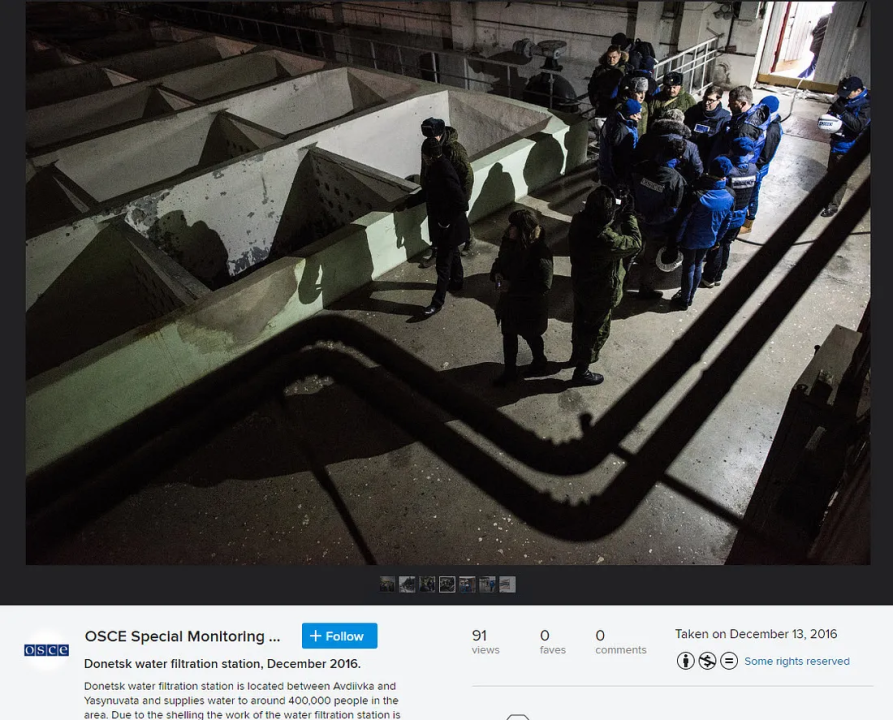A Digital Forensics Survey of the Last Week in the Donbas
Examination of a video of firing artillery, a disruption to water supplies, and reports of civilian casualties
A Digital Forensics Survey of the Last Week in the Donbas
Share this story

BANNER: Source: Left, Google Earth. Right, OSCE SMM to Ukraine YouTube video from January 12, 2016.
Fighting in the Donbas has cooled over the past few weeks, after the bloodiest week in months in the Svitlodardsk Bulge. However, even if the Ukrainian conflict is not grabbing international headlines, there have still been significant events impacting the civilians and soldiers in eastern Ukraine. This week, we are providing a roundup of the week’s events, with a focus on how we can better understand them through digital forensics. The three events we are highlighting:
— New video evidence of Minsk violations near Debaltseve;
— The disruption of water supplies to thousands of civilians near Donetsk;
— Video materials regarding a wounded civilian who suffered from a shrapnel wound in his home in Ukrainian-controlled territory.
OSCE Video of Firing Howitzers
On January 12, the OSCE SMM to Ukraine shared a video taken by its UAV, showing five howitzers just north of separatist-controlled Debaltseve firing northwest, towards government-controlled Svitlodarsk. The deployment and use of these weapons are obvious violations of the Minsk agreement.
The video was first geolocated by Twitter user @strannik_1981, and then with greater exposure by Julian Röpcke. Both geolocations were correct, placing the howitzers in a field just north of a railroad track by separatist-controlled Debaltseve.

The OSCE’s UAV was pointing to the south, meaning that the howitzers were pointing northwest — towards Svitlodarsk.

Disruption at the Donetsk Filtration Station
Last week, shelling was exchanged between separatist forces near Yasynuvata and government forces near Avdiivka, both north of Donetsk. As a result of the shelling, a power line was hit, cutting off electricity to a water filtration plant, the Donetsk Filtration Station, located at almost the exact midpoint between Avdiivka and Yasynuvata. This key piece of infrastructure provides water to 400,000 civilians in the Donbas.
At 7:40pm (Kyiv time), the message below from a pro-Ukrainian source appeared on Facebook, describing shelling near the Promzone — an industrial area in southeast Avdiivka.
Just 43 minutes later, the general director of the Avdiivka Coke Plant posted a message on Facebook describing how a power line was downed, cutting off the electricity to the Donetsk Filtration Station.
This information was confirmed the following morning by the OSCE SMM to Ukraine, noting that it received information on the power line to the station being damaged.
Ukrainian Armed Forces officers of the JCCC in Avdiivka stated that the electricity supply to the Donetsk water filtration station had been damaged by shelling previous night.
After the January 11 shelling, the Donetsk Filtration Station restored its service on January 14.
A look at the location of the Donetsk Filtration Station makes clear why the ongoing fighting between Avdiivka and Yasynuvata poses such a risk to the water supply of nearby civilians.

This incident was far from the first time that the Donetsk Filtration Station’s services were interrupted due to nearby artillery fire. On December 13, 2016, the OSCE SMM to Ukraine published a photograph of a recent visit to the Donetsk Filtration Station, where OSCE monitors inspected the facility.

In the week after the visit, the filtration plant had additional interruptions to its service due to nearby fighting, though it is unclear which side caused each interruption, as both Ukrainian and separatist forces fired shells in the area between Avdiivka and Yasynuvata.
Civilian Casualty in Krasnohorivka
On January 13, the OSCE SMM to Ukraine included a paragraph in their daily report about a civilian casualty in government-controlled Krasnohorivka.
The SMM followed up on a report of a civilian casualty. At a hospital in government-controlled Kurakhove (40km west of Donetsk) a man (aged 57) told the SMM that he had sustained shrapnel injuries to his left leg while sleeping in his apartment in government controlled Krasnohorivka (21km west of Donetsk) the previous night. The SMM saw his leg bandages had been stained with blood. Medical staff at the hospital said the man had been admitted to the hospital and immediately taken to surgery.
There were multiple video reports of shelling in civilian areas in Krasnohorivka on January 12, including one from the Donetsk Oblast police where the wounded man is shown in the hospital.
A TSN news report shows an unexploded 82mm shell near a residential sector of Krasnohorivka. In the report, the journalists interview the same woman as in the Donetsk police video, the wife of the wounded man described in the OSCE SMM to Ukraine daily report.
Lastly, a citizen using the YouTube name of Ivan Khandogy filmed a video of a damaged residential building in Krasnohorivka on January 12, with the title of “Krasnohorivka 12.01.2017. Shelling, with casualties :(“.
Going into next week, the main hot spots continue to be near the Promzone in Avdiivka and along the Svitlodarsk Bulge, located between Svitlodarsk and Debaltseve. Fighting has cooled since the escalations of mid-December, but flagrant violations of the Minsk accords continue to be recorded, both online and through traditional media outlets. We will continue to monitor the situations near Svitlodarsk and Avdiivka, along with the rest of the Donbas, with an eye on the civilian impact on both sides of the frontlines.

